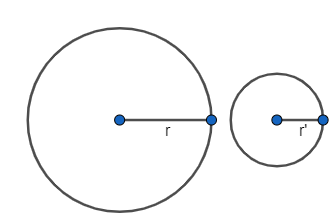
Answer
432k+ views
Hint: Here, we will apply the concept of circumference and area calculation of circle as well as percentage manipulation in their formula. There is one term common in the formula of circumference and area and i.e. value of radius, so we will use the first condition of the question for finding the new value of radius. We already know the initial formula of area, so that we will be having a new area of circle. At the end, we will apply the formula of percentage for determining decrement in the value of area.
Complete step by step answer:
Now, let’s look over the given condition, we have been given that circumference is reduced by 50%.
So, let the radius of the circle be r cm.
Then, circumference of circumference $C=2\pi r$.
Now, according to given condition,
New circumference of the circle will be $\left( 2\pi r\times \dfrac{50}{100} \right)$.
Let, new circumference $C'=2\pi r'$.
$\therefore C'=2\pi r'$.

So, we know, new circumference $\left( 2\pi r\times \dfrac{50}{100} \right)=\pi r$.
Therefore,
\[\begin{align}
& C'=2\pi r'=\pi r \\
& \Rightarrow 2r'=r \\
& \Rightarrow r'=\left( \dfrac{r}{2} \right) \\
\end{align}\]
Hence, the new radius of the circle would be $r'=\dfrac{r}{2}$.
Now, initially, we have
Area of circle, $A=\pi {{r}^{2}}$.
Let the new value of the area be A'.
Therefore, we already know, new radius $r'=\dfrac{r}{2}$.
\[\begin{align}
& \therefore A'=\pi r{{'}^{2}} \\
& \Rightarrow A'=\pi {{\left( \dfrac{r}{2} \right)}^{2}} \\
& \Rightarrow A'=\dfrac{\pi {{r}^{2}}}{4} \\
\end{align}\]
Now, for finding the reduction in area, we will apply the formula:
\[\%\text{ reduction in area}=\left( \dfrac{\text{initial area}-\text{final area}}{\text{initial area}} \right)\times 100\]
We know,
Initial area, $A=\pi {{r}^{2}}$.
Final area, $A'=\dfrac{\pi {{r}^{2}}}{4}$.
\[\begin{align}
& \%\text{ reduction in area}=\left( \dfrac{\pi {{r}^{2}}-\dfrac{\pi {{r}^{2}}}{4}}{\pi {{r}^{2}}} \right)\times 100 \\
& \Rightarrow \left( \dfrac{\dfrac{3}{4}\pi {{r}^{2}}}{\pi {{r}^{2}}} \right)\times 100 \\
& \Rightarrow \dfrac{3}{4}\times 100 \\
& \Rightarrow 75\% \\
\end{align}\]
So, the correct answer is “Option D”.
Note: Students should use the percentage formula carefully. In other words, we can say that we can’t use this percentage reduction formula in case of incrementation. Students generally apply this formula everywhere, but this would lead to negative answers in case of incrementation (like in our question if the value of new radius would increase, then we will apply percentage increment formula for that).
If this type of question is asked, then simply find the initial value and final value with the help of some correlating terms like here in the question, we have radius terms common in circumference and area.
Complete step by step answer:
Now, let’s look over the given condition, we have been given that circumference is reduced by 50%.
So, let the radius of the circle be r cm.
Then, circumference of circumference $C=2\pi r$.
Now, according to given condition,
New circumference of the circle will be $\left( 2\pi r\times \dfrac{50}{100} \right)$.
Let, new circumference $C'=2\pi r'$.
$\therefore C'=2\pi r'$.

So, we know, new circumference $\left( 2\pi r\times \dfrac{50}{100} \right)=\pi r$.
Therefore,
\[\begin{align}
& C'=2\pi r'=\pi r \\
& \Rightarrow 2r'=r \\
& \Rightarrow r'=\left( \dfrac{r}{2} \right) \\
\end{align}\]
Hence, the new radius of the circle would be $r'=\dfrac{r}{2}$.
Now, initially, we have
Area of circle, $A=\pi {{r}^{2}}$.
Let the new value of the area be A'.
Therefore, we already know, new radius $r'=\dfrac{r}{2}$.
\[\begin{align}
& \therefore A'=\pi r{{'}^{2}} \\
& \Rightarrow A'=\pi {{\left( \dfrac{r}{2} \right)}^{2}} \\
& \Rightarrow A'=\dfrac{\pi {{r}^{2}}}{4} \\
\end{align}\]
Now, for finding the reduction in area, we will apply the formula:
\[\%\text{ reduction in area}=\left( \dfrac{\text{initial area}-\text{final area}}{\text{initial area}} \right)\times 100\]
We know,
Initial area, $A=\pi {{r}^{2}}$.
Final area, $A'=\dfrac{\pi {{r}^{2}}}{4}$.
\[\begin{align}
& \%\text{ reduction in area}=\left( \dfrac{\pi {{r}^{2}}-\dfrac{\pi {{r}^{2}}}{4}}{\pi {{r}^{2}}} \right)\times 100 \\
& \Rightarrow \left( \dfrac{\dfrac{3}{4}\pi {{r}^{2}}}{\pi {{r}^{2}}} \right)\times 100 \\
& \Rightarrow \dfrac{3}{4}\times 100 \\
& \Rightarrow 75\% \\
\end{align}\]
So, the correct answer is “Option D”.
Note: Students should use the percentage formula carefully. In other words, we can say that we can’t use this percentage reduction formula in case of incrementation. Students generally apply this formula everywhere, but this would lead to negative answers in case of incrementation (like in our question if the value of new radius would increase, then we will apply percentage increment formula for that).
If this type of question is asked, then simply find the initial value and final value with the help of some correlating terms like here in the question, we have radius terms common in circumference and area.
Recently Updated Pages
How many sigma and pi bonds are present in HCequiv class 11 chemistry CBSE

Mark and label the given geoinformation on the outline class 11 social science CBSE

When people say No pun intended what does that mea class 8 english CBSE

Name the states which share their boundary with Indias class 9 social science CBSE

Give an account of the Northern Plains of India class 9 social science CBSE

Change the following sentences into negative and interrogative class 10 english CBSE

Trending doubts
Difference Between Plant Cell and Animal Cell

Difference between Prokaryotic cell and Eukaryotic class 11 biology CBSE

Fill the blanks with the suitable prepositions 1 The class 9 english CBSE

Differentiate between homogeneous and heterogeneous class 12 chemistry CBSE

Which are the Top 10 Largest Countries of the World?

One cusec is equal to how many liters class 8 maths CBSE

Give 10 examples for herbs , shrubs , climbers , creepers

The mountain range which stretches from Gujarat in class 10 social science CBSE

The Equation xxx + 2 is Satisfied when x is Equal to Class 10 Maths



